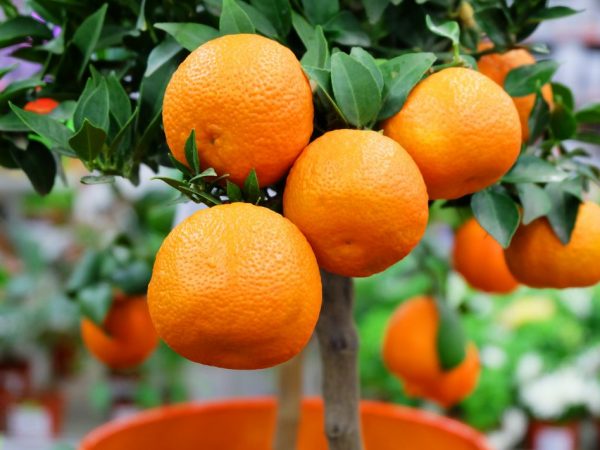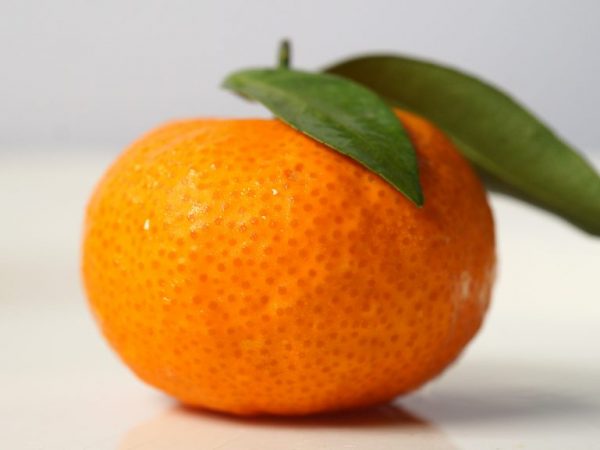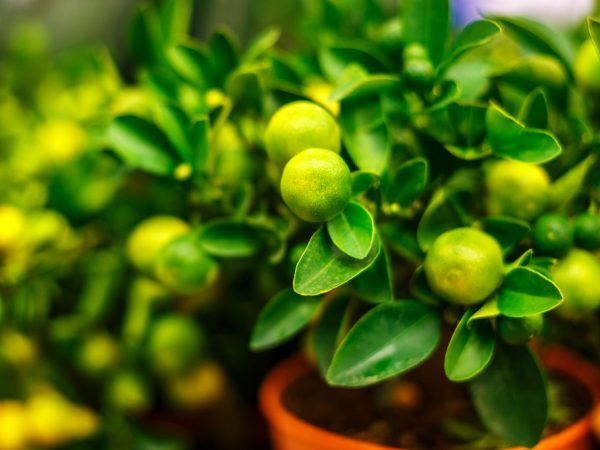Mandarin description
Citrus fruits are fruits useful for the human body. In winter, tangerines are especially popular because they contain a large amount of vitamins in their composition. It is necessary to study the detailed description of mandarin in order to grow it yourself.

Mandarin description
Variety characteristic
According to the botanical classification, the fruit belongs to the Citrus species and the Rutaceae family. Mandarins are evergreens and do not shed their leaves. China is considered the homeland of the Mandarin.
The variety grows in warm climates, in particular, in the East, in the Mediterranean, in the Transcaucasus.
Resistant Japanese varieties are grown even in Russia, in the Krasnodar Territory. Everything has already been studied about tangerines, so these fruits are grown at home from a stone or cuttings.
Description of the tree
The root system of the tree is spreading and powerful, much larger than the crown. Under natural conditions, the structure of a tree is as follows:
- spherical crown;
- an abundant amount of leaves;
- oval or ovoid foliage;
- monochromatic leaves from light green to rich dark green.
Height up to 4 m, in adulthood, about 30 years, - up to 5 m;
The tree usually blooms in May. The flowers are solitary, dull white.
The petals are elongated, with sharp ends, with a light yellow pistil and many stamens.
Mandarin begins to bear fruit at 3-4 years old. The fruits ripen in November-December.
Description of the fetus
Outwardly, the fruit is similar to the fruits of other citrus fruits. Its peculiarity is the peel, which is easily removed from the fruit.
Mandarin fruits look like this:
- diameter - 4-6 cm, weight - up to 140-150 g;
- flattened above and below;
- the peel is thin, sometimes separated from the fruit by an air cushion;
- a small amount of seeds, in some varieties they are completely absent.
Taste qualities

Mandarin is good for the body
The fruits are almost always sweet. In the context, mandarin fruits are similar to other citrus fruits, but the pulp has a number of differences:
- the lobules of this plant are smaller than those of congeners; there are 10-12 pieces in one fruit;
- are bags filled with juice;
- such an organization resembles the fruit of a berry;
- has a pronounced aroma that is significantly sweeter than other citrus fruits.
Benefit and harm
citrus is good for the human body. Most of all in fruits:
- potassium (155 mg per 100 g);
- calcium (35 mg);
- phosphorus (17 mg).
Also, mndarin is rich in vitamins C, A and trace elements.
Sweet Citrus fruits are considered a dietary food. It is difficult to overdo it with them, a lethal dose, given the amount of vitamins and minerals, is about 2-4 kg. Like any citrus, mandarin is a strong allergen.
Fruits are not recommended to be eaten on an empty stomach because the acid irritates the stomach walls.
Fruit application
The fruit is actively used not only in cooking, but also in everyday life. Interesting applications of the product:
- jam, jams are made from it, they are used to decorate confectionery and main dishes;
- the slices are dried and consumed as dried fruits (even dried fruits retain vitamin C), and also squeeze out the juice;
- get essential oils with a powerful smell, which are used in cooking, cosmetology (face and hair care);
- in folk medicine, infusions and decoctions from the peel are used to prolong the effect of painkillers.
How to choose a fruit

Ripe fruit has a smooth skin
To get all the usefulness from the fruit and not harm yourself, it is important to choose the right fruit. This is especially true out of season, when chemicals are used to grow the product, and the shelf life is artificially extended. How to pick a good tangerine in the store:
- ripe fruit splashes juice from the skin when pressed;
- good tangerine contains no skin spots, external damage, areas of rot and mold;
- soft areas on the fruit are a sign of freezing, such a fruit should not be taken;
- dried or too softened peel indicates staleness;
- sweet fruits are usually medium in size, their skin is bright orange; they are usually heavier than sour citrus fruits.
Now there are many varieties of tangerines: Turkish, Abkhaz, Spanish, Moroccan), which differ in appearance and taste. Knowing the differences between these varieties, it is easy to choose the fruit to taste.
Care
When deciding to plant tangerine plants at home, you should be prepared for a whole range of caring for it. The fruit is especially vulnerable in winter. Citrus yields only after 4-5 years.
The following facts about plant care are also helpful:
- The sprouts obtained from the seed or cuttings are planted in a special soil for citrus fruits. It is neutral and does not contain peat. The seeds are buried 4 cm deep (it is better to take several in order to increase the chance of germination). The seed sprouts within 15 days at temperatures between 20 ° C and 25 ° C.
- Young trees are transplanted every year, and those that bear fruit - every 2-3 years, while the diameter of the pot for them is increased by 4-6 cm. The pot must be equipped with a drainage system.
- The tree needs a sunny place with protection from rain and wind, no drafts with moderate humidity.
- From June to the end of August, the tree is exposed to the street. The plant hibernates only in an apartment with temperatures between 2 ° C and 10 ° C. Necessarily in a well-lit place.
Watering the plant
It is important to observe the watering regime. The roots of the tree should be moderately moist. Before watering, check the soil for moisture with your finger.
On hot summer days, the plant requires more water, and in winter it is worth watering less often. Spraying with warm water is carried out every day.
How to fertilize
Fertilize tangerine with substances with a high nitrogen content and a small amount of phosphorus. Fertilization in winter is contraindicated.
Wintering is a dormant time for a plant; it is not recommended to move it. The room is ventilated from time to time.
Pruning

Periodically, the tree needs to be pruned.
Pruning the bush is an important ingredient in tangerine care. Places of cuts are treated with wood resin. Pruning goals:
- remove dead, weak, too thin branches;
- stimulate plant growth;
- give the tree a round shape, otherwise the foliage will grow.
Sharp garden shears are used for pruning. The procedure is carried out only before flowering or immediately after it; branches with fruits cannot be cut off.
Pests and diseases
Pests affect the harvest of the tree and destroy the plant.
The reasons for the appearance of pests and diseases are external factors, improper care and an unsuitable microclimate.
The main pests affecting the tree:
- sticky scabbard (located on the lower part of the leaves, the sign is sticky discharge, similar to syrup);
- spider mite (thin cobwebs appear on the tips of the shoots);
- aphid.
Pests are fought with means that are sparing for people and plants. For example, the leaves are treated with soapy water, infusions from natural ingredients (onions, garlic, chili) or special chemicals.
Diseases that are inherent in tangerine are often caused by a fungus. Among them are:
- anthracnose (the causative agent is a pathogenic fungus);
- citrus cancer (bacteria infect the leaves and fruits of the tree with dark brown spots);
- late blight (fungal root disease);
- tristeza (called by the name of the virus, it is dangerous for plants over 5 years old).
Citrus cancer, late blight are incurable diseases, so the affected plant is dug up and destroyed.
Conclusion
The tangerine tree is an exotic plant that decorates the interior and bears delicious fruits. To grow healthy fruits, you must follow many rules of care, monitor the health of the tree, and carry out the necessary set of procedures.


